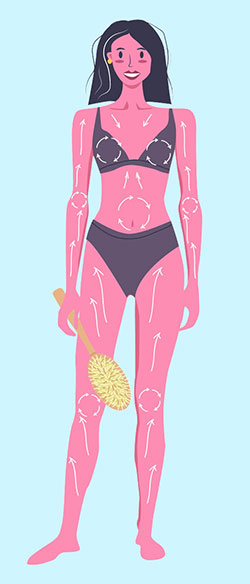Dry brushing is a special self-massage with a natural bristle brush. Proponents of this technique believe that it helps with circulation, detoxification, and improves dry skin. Some believe that dry brushing detoxifies by stimulating lymph flow which improves the function of the lymphatic system. The massage is performed by brushing the extremities, starting at the feet, in wide, circular, progressive motions toward the core.
Can dry brushing help with lymphedema?

No scientific studies exist around lymphedema and dry brushing, however, regular practitioners of this technique believe that it helps in reducing swelling. Unlike the circulatory system, which has an active pump (the heart) circulating blood throughout the body, the lymphatic system does not have a pump. When fluid is stagnating and causing swelling, aiding in the movement of the fluid by gently brushing the surface of the skin in circular strokes toward the core may help. Dry brushing the skin can exfoliate skin and increase circulation to the skin surface, which can aid in keeping the skin healthy. Having healthy skin is an important part of lymphedema care. Dry skin can lead to cracking that can introduce infection into the body, which can be very dangerous for lymphedema patients.Some lymphedema therapy practitioners do include dry brushing as part of their lymphedema self-care routines for their patients. They recommend that dry brushing is performed in the morning, preferably before a morning shower, for best results, the dry brushing should be done from the feet up toward the torso and from the fingertips up the arm and toward the core. The core should be brushed in a circular motion, the whole process should take approximately 15 minutes. After dry brushing hop into your morning shower, after your shower, complete the process by applying a pH balanced moisturizer.
Is dry brushing safe for lymphedema?
If you are interested to learn if dry brushing can be safe and effective for you, it is always best to speak with your lymphedema therapist. If you have any cracked skin, open wounds, bruises, or signs of infection it is best not to dry brush that area as you risk introducing bacteria into the wound or spreading an infection that’s below the surface. Be gentle and do not exert excessive pressure when brushing. Stop dry brushing if skin becomes irritated or inflamed. If you’re recovering from a recent surgery or radiation treatment, it is best to consult your medical team about if and when dry brushing is safe for you.
The content is not intended to be a substitute for professional medical advice, diagnosis, or treatment. Always seek the advice of your physician or another qualified health provider with any questions you may have regarding lymphedema. Never disregard professional medical advice or delay in seeking it because of something you have read on the internet.
